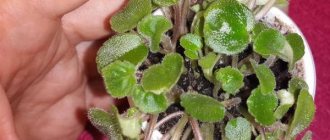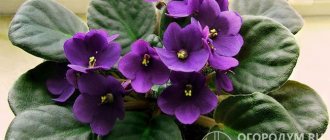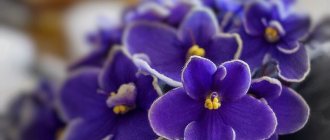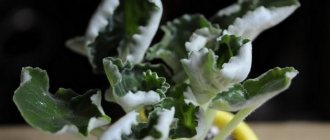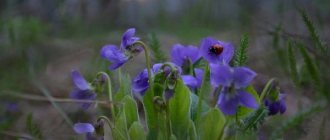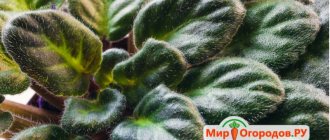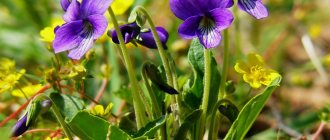When do we feel truly happy? When a business in which a person puts his love and work brings not only material profit, but also fills the heart and soul with warmth and joy .
Such happy people undoubtedly include flower growers - breeders.
It is thanks to their efforts, love for their work, and patience that wonderful varieties of new plants appear,
in our case mini violets . A bright representative of the “neophytes” is the violet “N - forest spring” - a small “fluffy, blue-eyed” miracle on your windowsill. In the article you will see a photo and description of the variety.
Violet N-Forest spring (N. Berdnikova)
Sweet violet Forest spring.
This is a mini violet. Its buds look like a spring forest “forest” in miniature.
Advantages of mini violets:
- Leaf rosette of symmetrical regular shape, compact, small in size;
- The inflorescences are small, numerous, on erect stems;
- This variety of violets looks good in group compositions and as an independent potted flower;
- Rapid formation of an adult flowering plant.
The variety has many advantages.
Species features:
- The buds are no more than 5 cm in diameter. They have a bell shape. The color of the petals ranges from soft blue to rich blue; the tips are decorated with a white border. Lush abundant flowering;
- The leaves are dense, rich green in color with white, unevenly spaced spots;
- Characterized by abundant pinching of the rosette;
- The leaf part and flowers are covered with hair;
- The plant is characterized by a rapid increase in vegetative mass and propagates well by cuttings.
Author of the variety
The author of this “fluffy miracle”, like many other varieties of mini-violets, is Nadezhda Dmitrievna Berdnikova:
- Formerly an ophthalmologist;
- And then the vet;
- He is currently enjoying a well-deserved pension.
Like most Russian pensioners, Nadezhda Dmitrievna exchanged urban conditions for “fresh air” - she moved to a dacha near Moscow, where she began breeding mini violets. From her caring hands more than 40 new bright “babies” were born.
It is easy to find plants bred by her in catalogs - they have the letter “H” in the name of the variety .
ATTENTION! Due to his advanced age, the florist is not able to attend exhibitions and present his works at them. Nesterov’s assistant Margarita is doing this on her behalf.
Popular varieties
Trailer violets are some varieties with an elongated stem and have several growing points. Most of the time they are in a flowering state. They are divided into groups according to their size.
The following varieties were created by domestic breeders:
- Balchug Intuition, Yeti, Dream (Igor Milekhin);
- SK-Volushka, SK-Confiture (Alexey Kuznetsov);
- Rob's Antique Rose, Honey Berry (Ekaterina Zybinova).
The Osa variety is especially distinguished (mini violet Bee is another name). The peculiarity of this Saintpaulia is in the petals, two of them are rolled into a tube, and three hang freely down. Selection of these varieties has been carried out for a long time, but diversity has not yet been achieved.
Conditions for cultivation
Like all representatives of this mini variety, the violet “N - Forest Spring” needs appropriate care , which is not complicated, accessible even to a novice gardener and consists of the following.
This variety requires proper care.
Air temperature and humidity
The best temperature regime for an adult plant is in the range from 20 to 22 degrees Celsius (night temperature 17-19 degrees). For cuttings or during a post-stress period, the temperature must be increased to 24 - 26 degrees (it is advisable to create greenhouse conditions for the plant - provide high humidity).
The flower does not tolerate:
- Sharp fluctuations in temperature;
- Drafts.
In winter, during severe frosts, the violet must be “relocated” from the windowsill to another, warmer place.
An air temperature not exceeding 17 degrees helps the plant form compact rosettes . The characteristics of varietal flowering buds become clearly expressed.
The death of violets can be caused by temperature:
- Extremely low (less than 12 degrees);
- And extremely high (more than 30).
When the air is dry (central heating is on in winter), the bud formation is minimal, and those that managed to bloom :
- They become smaller;
- Lose their bright color;
- And they fade quickly.
During the hot summer months (mid-July - late August), it is better to ensure peace for the violet , since at this time the flowering period freezes.
Violet loves moist air.
IMPORTANT! A young plant (not more than half a year old) can show bright, abundant flowering. At the end of the budding period, the size of the violet remains the same or changes dramatically.
The soil
A properly selected planting mixture is a guarantee that your flower will not only take root, but will also bloom magnificently.
Main soil conditions:
- High air and water permeability;
- Looseness;
- Ease.
The basis of the substrate is soilless peat mixtures (purchased in specialized stores). Additional component:
- Perlite (mixed with soil);
- Or fine-grained expanded clay for drainage (an alternative is a layer of sphagnum moss at the bottom of the pot, with a little medium-fraction charcoal on top).
Lighting
Another important factor when growing Saintpaulia is lighting. Violet “N – Forest Spring” requires intense lighting for normal growth and development. Resistant to bright natural light. Feels great on the windowsill (at a distance of at least 30 cm from the window glass).
additional lighting for a while (about 4 hours), which will help the flower form bright buds.
In winter, Saintpaulias require additional lighting.
ATTENTION! The lamp should be located at a height of no more than 0.4 m above the plant.
Varieties of miniature Saintpaulias
There are about 15,000 varieties of Saintpaulias in the world. And only 3000 of them are varieties of non-standard dimensions. Their distinctive feature is their tiny size. Fully grown babies do not exceed 20 cm in diameter. The flowers are small, only 2-3 cm, but there are so many of them on the peduncles that they often overlap the plant itself. Baby Saintpaulias are usually divided into three varieties:
- Mini violets. The diameter of their leaf rosette is 15 cm.
- Semi-miniature Saintpaulias. Their sizes are slightly larger - 20 cm in diameter.
- Micromini. Tiny plants are very rare, their size is only 6 cm. Micro-mini violet requires special conditions. Therefore, only the most experienced violet grower can cope with its maintenance.
Photo of mini violets
Foreign and domestic breeders are working painstakingly to create new varieties. Wonderful varieties of miniature violets are constantly appearing, gaining popularity and love throughout the world.
Varieties by I. Milekhin and A. Kuznetsov
Many varieties of mini violets were bred by the famous breeder Igor Milekhin. He created delightful varieties of violets, striking in their beauty. These tiny beauties include the following varieties: Balchug Intuition, Balchug Yeti, Balchug Mechta, Balchug Stay, Balchug Sweet Life. Another famous breeder who breeds mini and semi-mini violets is Alexey Kuznetsov. Thanks to his work, such delightful varieties as SK-Pangea, SK-Soblazn, SK-Dance of the Crane, SK-InVinoVeritas, SK-Osminozhka, SK-Apple Garden saw the light of day. Let's look at some of them in more detail.
Balchug Intuition
Mini violet variety I. Milekhina - Balchug Intuition at first sight evokes admiration. A whole cloud of delicate, semi-double white and pink flowers forms on the peduncles. They are quite large - about 4 cm in diameter. The border on the petals is a more pronounced pink color, as is the inside of the flower.
Petals with a wavy edge add even more charm to the variety. The leaf rosette is symmetrical and neat. The leaves are rounded, green, arranged in a bunch in proportional rows. This variety is a godsend for beginning amateur gardeners. It does not require special care, it is not capricious, flowering lasts long and abundantly.
Photo of mini violets
Apple orchard
More recently, in 2012, the Apple Orchard mini violet, created by A. Kuznetsov, appeared. The most delicate variety with a pink and white cap of flowers. It blooms profusely, covering a small rosette of leaves with delicate, elegant bouquets. This lush color is ensured by strong peduncles, on which there are 8-10 flowers, with a diameter of 2.5-3 cm. The petals are white, framed by a thin, pink edge. Flowering lasts a long time, about 2 months.
With excessive feeding or constant exposure to sunlight, the flowers may turn purple. Therefore, it is necessary to provide the flower with proper care - do not expose the petals to aggressive exposure to the sun and do not overdo it with fertilizers.
Photo of mini violets
Variegated
Among the many varieties of mini-violets, variegated varieties stand out for their originality. Their value lies not only in the beauty of the flower stalks. The leaves with a cheerful, variegated color give the plant a special decorative appearance. Such varieties will delight the soul even after their flowering ends. Against the background of dark green velvet foliage, creamy, chaotically located specks flaunt.
Toronto Belle - variegated beauty from Toronto
Mini Saintpaulia Toronto Belle is one of the best representatives of variegated tiny violets. Her unusual appearance will not leave anyone indifferent. The flowers are simple, light lilac, on tall peduncles. The leaves are creamy green, with pronounced specks. According to the type of structure, they belong to gel-leaves - even leaves form a corrugated edge at the base (at the junction with the petiole).
Photo of mini violets
Features of flowering
Violet “N – Forest Spring” is a profusely flowering variety . According to the type of flowering, it belongs to the “bouquet” varieties. Flowering duration is 1.5 - 2 months, then the dormant period is about 3 months.
The young plant begins to bloom abundantly within six months from the moment of planting, under all correctly observed conditions:
- High-quality soil substrate;
- Timely watering;
- Illumination;
- Temperature conditions;
- Love and care.
Growing violets on capillary mats
Using capillary mats, the owner solves two problems at once - timely watering and maintaining the required level of humidity. The effectiveness of this device lies in the correct fit. A mixture of sphagnum moss and charcoal is used as drainage. Moisture saturates the moss, which, in turn, distributes it evenly in the soil. Water evaporates while on the mat, thereby maintaining a certain level of humidity.
Growing methods
Violet “N – Forest Spring” requires attention and care , prefers conditions close to greenhouse. The seating area (even for group compositions) should be individual - a small pot.
Since the flower belongs to the “variegated leaf” group, the greenest leaf of “middle” age is selected for its propagation (plucked by hand).
Planting process:
- The selected leaf is washed with soft water (settled tap water at room temperature);
- The cuttings are trimmed, leaving a stem no more than 1.5 cm long;
Saintpaulia requires replanting once a year. - After drying (about 10 minutes), the tips are sprinkled with crushed ash or dipped in a broad-spectrum fungicidal solution for 1-2 minutes;
- Then they immediately root into the prepared substrate, which should be : Light;
- Porous;
- Breathable;
- Waterproof;
- A drainage layer is required.
ADVICE! Emerging mini-rosettes (3 or more young leaves) can be separated from the mother leaf and planted immediately in a permanent place (a separate pot).
Unfortunately, the author of the variety, breeder Nadezhda Dmitrievna Berdnikova, did not provide publicly available information on the propagation of violets “N – Lesnoy spring” by seeds. But the cutting method is more than accessible and guarantees good results.
Reproduction
Most often, propagation of mini-violets is carried out using a leaf with a cutting. To do this, the healthiest leaves of an adult violet are selected and cut off. If it is a variegated variety, you should pay attention to the color of the leaf. You need to choose a leaf with a predominant green color for propagation. White foliage with a small amount of green splashes will not produce babies.
Photo of mini violets
Prepared leaf cuttings are rooted in a moist soil mixture consisting of peat and prelite. The cuttings are planted at a shallow depth (about 1 cm) to speed up the appearance of new rosettes. There is no need to press down the soil around the leaf; the soil should remain loose. After the babies appear on the surface of the soil, they are transplanted to a permanent place in pots.
By choosing mini Saintpaulias as a houseplant, the gardener not only saves free space on the windowsill. Baby violets are not inferior in beauty to their large sisters, especially if you collect them in groups. They enter the flowering period earlier, give lush caps of exquisite and delicate flowers and perfectly decorate the home.
Rules of care
Caring for mini violets does not require complex agrotechnical skills. You need to know and follow a few simple rules.
Watering
The mini violet must be watered carefully.
Water for irrigation should be soft - tap water at room temperature. For only planted flowers and for 12–14 days, 2–3 degrees warmer.
to water along the edge of the pot so that moisture does not fall on the plant. The soil substrate must be completely moistened.
In the spring-summer period, watering is optimally carried out in the morning hours; in the autumn-winter period, watering is transferred to daylight hours (12-16 hours), the frequency is reduced.
Top dressing
Violet, like any indoor plant, needs fertilizer. It is better to fertilize the mini violet “N – Forest Spring”:
- Basal;
- Liquid preparation.
The modern chemical industry produces compounds designed specifically for such “babies”.
Fertilizer selection:
- For seedlings . The proportion of nitrogen, phosphorus and potassium should be 2:1:1;
- For the formation of flower buds and good development of buds. The ratio of microelements changes – 1:2:1;
- Intensity and duration of the budding period. 1:1:2.
Diseases and pests: prevention and treatment
The plant may be susceptible to the following diseases :
- Putrefactive lesions. Caused by fungi that parasitize the roots of a flower or leaf part - “gray rot”. They can cause the death of the plant. With minor damage, the disease can be stopped by separating healthy leaves and transferring them to a new place with fresh soil. Prevention is treatment with chemicals - fungicides;
Most often, violets have diseased leaves. - The appearance of plaque and spotting . Prevention is to prevent stagnation of moisture in the soil substrate. Treatment – removal of the affected parts, replanting the plant. An extreme case is treatment with drugs;
- Insects - pests:
- Thrips;
Ticks.
They are combated using chemicals. For complete destruction, treatment is carried out with a one-week break 2 times.
IMPORTANT! To combat diseases and pests, chemical industry products should be used only in extreme cases, and the most gentle preparations should be chosen. Carry out processing only in a well-ventilated area.
